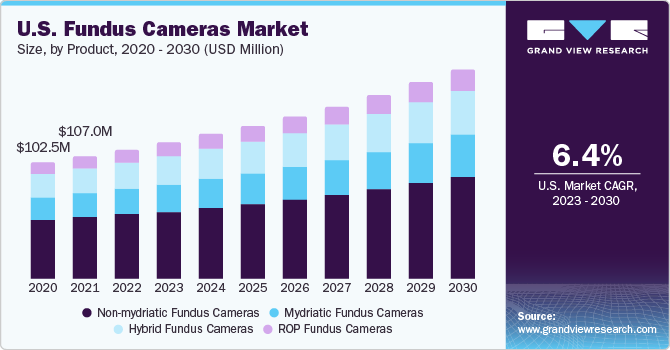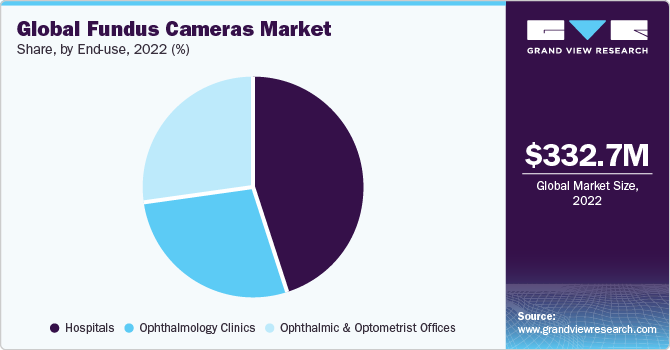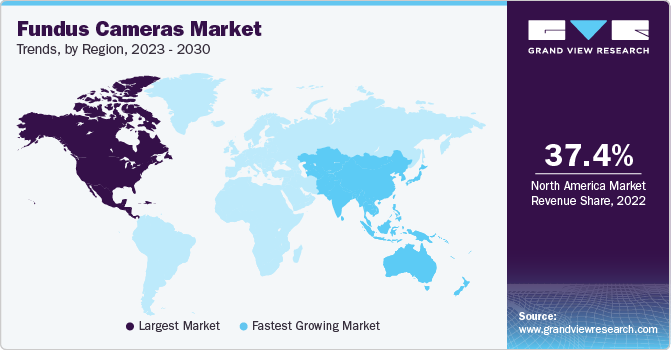- Home
- »
- Medical Devices
- »
-
Fundus Cameras Market Size, Share & Growth Report, 2030GVR Report cover
![Fundus Cameras Market Size, Share & Trends Report]()
Fundus Cameras Market Size, Share & Trends Analysis Report By Product, By End-use (Hospitals, Ophthalmology Clinics, Ophthalmic & Optometrist Offices), By Region (North America, Europe, Latin America, MEA), And Segment Forecasts, 2023 - 2030
- Report ID: GVR-1-68038-346-1
- Number of Pages: 140
- Format: Electronic (PDF)
- Historical Range: 2018 - 2021
- Industry: Healthcare
Fundus Cameras Market Size & Trends
The global fundus cameras market size was valued at USD 332.7 million in 2022 and is anticipated to grow at a compound annual growth rate (CAGR) of 6.2% from 2023 to 2030. The increasing geriatric population and chronic disorders, such as diabetes and hypertension, are responsible for the growth in the incidence of retinal disorders. Key retinal disorders include Diabetic Retinopathy (DR), Age-related Macular Degeneration (AMD), and Retinopathy of Prematurity (ROP). Furthermore, increasing awareness about eye disorders and commercializing several technologically advanced products are likely to propel the market during the forecast period.

Due to the rising incidence of chronic diseases like hypertension, diabetes, and geriatrics, retinal abnormalities are on the rise. The market is anticipated to expand due to rising awareness of eye problems and the launch of numerous cutting-edge products. Artificial intelligence, machine learning, and big data have enormous potential for improving healthcare. Diagnosing illnesses such as DR has proven to be quite accurate with the inclusion of AI in fundus cameras. It has been demonstrated that machine learning algorithms may detect eyes at risk for postoperative myopic regression following refractive surgery by using preoperative fundus photography in conjunction with other preoperative parameters, including anterior chamber depth, central corneal depth, age, and intended ablation thickness.
Diabetic eye diseases consist of several eye conditions, including DR, diabetic macular edema, glaucoma, and cataracts. According to the National Eye Institute (NEI), in the U.S., diabetic retinopathy patients in America are expected to double from 7.7 million in 2010 to 14.6 million in 2050. In addition, advancements in the field are expected to drive the market during the forecast period. COVID-19 has negatively impacted the market as the data captured during the pandemic was not accurate and sufficient to determine the eye problem. Lack of data limited the tracing of disease, its management, and treatment. However, handheld fundus cameras were a useful option due to their ability to capture retinal changes in COVID-19 patients in different settings or locations.
The development of digital cameras, red-free fundus cameras, film-based fundus cameras, and other tools for clear and detailed fundus imaging are likely to lead to market growth throughout the projected period. Additionally, supportive government policies are anticipated to promote corporate expansion. According to the rules and regulations of medical device agencies in the U.S. and Japan, fundus imaging cameras must be updated every four years. By ensuring the quality of the equipment, this regulation improves diagnosis and treatment. The law is likely to maintain and increase the country's need for electronics.
COVID19 impact: Demand for handheld fundus camera increases by more than 15% as compared with 2019
Pandemic Impact
Post COVID Outlook
The year 2020 marked a temporary decline in sales of the fundus camera owing to limited access to ophthalmic care
The ophthalmologists are relying on handheld fundus cameras to maintain a safe distance with patients. The handheld segment is expected to exhibit a CAGR of more than 8% from 2021 to 2028 as compared to a previously calculated CAGR of 6% in a non-COVID scenario
Increasing cases of mucormycosis as COVID-19 comorbidity is causing the need to assess eye health for each patient.
The patients may require long-term monitoring for any ophthalmic conditions post COVID-19 recovery. This is expected to increased footfall in ophthalmology departments and needs additional diagnostic equipment including fundus cameras.
However, pricing pressure and competition from other developed technologies are expected to hinder market growth. Optical Coherence Tomography (OCT) is an advanced technology developed for retinal reimaging. The technology provides detailed retina and optic nerve images, viewable in 2D and 3D formats. Furthermore, swept-source OCT is the latest generation of Fourier domain OCT technology. Advantages associated with swept-source OCT are better sensitivity and faster speed than OCT.
Product Insights
Based on product, the market is segmented into hybrid fundus cameras, non-mydriatic fundus cameras, mydriatic fundus cameras, and ROP fundus cameras. The non-mydriatic cameras segment dominated the market and accounted for the largest market share of 49.5% in 2022. It improves the ability of a practitioner to view and observe detailed retinal anatomy, thereby improving the diagnosis and management of eye diseases. Furthermore, non-mydriatic cameras use fundus photography, eliminating the need for dilating drops and bright lights; hence, fundus photography is more patient-friendly. This property also helps glaucoma patients for whom dilation is contraindicated. Advancements in non-mydriatic cameras, such as fluorescein imaging, portability, and live-action systems, are anticipated to drive the market during the forecast period.
The hybrid fundus cameras segment is estimated to register the fastest CAGR of 6.8% over the forecast period. The mydriatic fundus cameras segment accounted for around 20.0% share in 2022. The low share of the mydriatic camera or traditional fundus camera is attributed to the necessity of pupil dilation with the help of bright light or dilating drop to obtain a clear image of the retina. This is not comfortable for patients suffering from glaucoma and photosensitivity. Furthermore, advancements in the fundus cameras provide more clear, quick, and reliable images of the retina, which has resulted in a decrease in the demand for mydriatic cameras. Lower investment by industry players due to the low demand for mydriatic cameras may restrain the market's growth during the forecast period.
End-use Insights
Based on the end use, the market is segmented into hospitals, ophthalmology clinics, and ophthalmic & optometrist offices. The hospital segment accounted for the largest revenue share of 44.9% in 2022. Hospitals include secondary care, tertiary care, and advanced care. Hospitals are mostly preferred for pediatric eye care services and complicated procedures where one or more ophthalmologists and diagnostic and surgical support services are available. However, preference for specialty eye clinics, such as ophthalmologist and optometrist offices, may restrain the market's growth.
The ophthalmic & optometrist offices segment is estimated to register the fastest CAGR of 6.9% over the forecast period due to increasing optometrist practitioners, preference for primary eye care, and low-cost services by ophthalmic and optometrist offices compared to ophthalmologists. Furthermore, a stagnated supply of ophthalmologists allows optometric offices to dominate the market. For instance, the lack of ophthalmologists in low-income countries in the Asia Pacific, Latin America, and Africa increases the demand for optometrists in emerging regions.

Highly skilled ophthalmologists and comprehensive eye examinations in clinics are expected to increase the demand for ophthalmology clinics for complex situations. However, the high examination cost, lack of ophthalmologists, and low patient preference for consulting ophthalmologists for primary eye care may restrain the market's growth. For instance, in 2022, about 19,216 ophthalmologists were practicing in the U.S., which is expected to remain stable until 2030.
Regional Insights
North America dominated the fundus cameras market and accounted for the largest revenue share of 37.4% in 2022. Major factors contributing to the growth of this region include the increasing geriatric population and technical advances in the field. Furthermore, the approval and launch of fundus cameras in the U.S. and Canada and the high adoption of new technologies will likely boost the market share. The widening application of fundus cameras for early detection and screening for eye diseases and lifestyle-associated diseases is anticipated to propel the market during the forecast period.
In Europe, the market is likely to witness a CAGR of 6.3% over the forecast period due to the local presence of major market players, technological developments in fundus cameras, such as easy-to-use, portability, and development of hybrid cameras, and adoption of newer products. For instance, key players such as Carl Zeiss Meditec Group, Optomed Oy (Ltd.), and CenterVue SpA are headquartered in Europe. In November 2022, Optomed announced the release of Aurora IQ, a handheld fundus camera with built-in artificial intelligence for quicker eye inspection. Furthermore, a rising number of diabetic retinopathy patients and the geriatric population is expected to boost the overall market during the forecast period.

Asia Pacific is expected to grow at the fastest CAGR of 6.4% during the forecast period because of the local presence of key players, the availability of expert services, and growing medical tourism. In Asia Pacific, the market is driven by China, Japan, India, and Australia. Japan dominated the market in terms of revenue share in 2020. This can be attributed to the local presence of major market players and a large geriatric population pool, whereas China is anticipated to register the fastest growth during the forecast period in the Asia Pacific.
Key Companies & Market Share Insights
Key strategies of the company include the expansion of the global sales network, the establishment of new production systems, and the enhancement of R&D capabilities. In January 2023, Topcon Healthcare, a leading provider of medical devices and software solutions for the global eye care community, announced the launch of NW500, its new user-friendly, robotic fundus camera that delivers reliable, sharp-quality imaging even in ambient light. The NW500 contributes to a streamlined workflow and enhanced patient experience by offering the ability to acquire retinal images in a lighted setting without dilating patients.
In July 2021, Topcon Corporation, a leading provider of medical devices and software solutions for the global eye care community, announced the acquisition of VISIA Imaging S.r.l, an ophthalmic device manufacturer headquartered in Florence, Italy. The acquisition enhances Topcon’s development and manufacturing capabilities of anterior segment devices and software, which complements the company’s strong portfolio of posterior segment imaging devices, including fundus cameras. Such strategic initiatives by the market players are expected to drive the market during the forecast period.
Key Fundus Cameras Companies:
- Carl Zeiss Meditec, Inc.
- Kowa Company Ltd.
- Optomed Oy (Ltd.)
- Optovue, Incorporated
- CenterVue SpA
- NIDEK Co., Ltd.
- Topcon Medical Systems, Inc.
- Clarity Medical Systems, Inc.
- Canon, Inc.
Fundus Cameras Market Report Scope
Report Attribute
Details
Market size value in 2023
USD 351.0 million
Revenue forecast in 2030
USD 535.0 million
Growth rate
CAGR of 6.2% from 2023 to 2030
Base year for estimation
2022
Historical data
2018 - 2021
Forecast period
2023 - 2030
Report updated
December 2023
Quantitative units
Revenue in USD million, and CAGR from 2023 to 2030
Report coverage
Revenue forecast, company ranking, competitive landscape, growth factors, and trends
Segments covered
Product, end-use, region
Regional scope
North America; Europe; Asia Pacific; Latin America; MEA
Country scope
U.S.; Canada; UK; Germany; France; Italy; Spain; Denmark; Sweden; Norway; Japan; China; India; Australia; South Korea; Thailand; Brazil; Mexico; Argentina; South Africa; Saudi Arabia; UAE; Kuwait
Key companies profiled
Carl Zeiss Meditec, Inc.; Kowa Company Ltd.; Optomed Oy (Ltd.); Optovue, Incorporated; CenterVue SpA; NIDEK Co.Ltd.; Topcon Medical Systems, Inc.; Clarity Medical Systems, Inc.; Canon, Inc.
Customization scope
Free report customization (equivalent up to 8 analyst’s working days) with purchase. Addition or alteration to country, regional & segment scope
Pricing and purchase options
Avail customized purchase options to meet your exact research needs. Explore purchase options
Global Fundus Cameras Market Report Segmentation
This report forecasts revenue growth at global, regional, and country levels and provides an analysis of the latest industry trends in each of the sub-segments from 2018 to 2030. For this study, Grand View Research has segmented the global fundus cameras market report based on product, end-use, and region:

-
Product Outlook (Revenue, USD Million, 2018 - 2030)
-
Mydriatic Fundus Cameras
-
Tabletop
-
Handheld
-
Non-mydriatic Fundus Cameras
-
Tabletop
-
Handheld
-
Hybrid Fundus Cameras
-
ROP Fundus Cameras
-
-
End-use Outlook (Revenue, USD Million, 2018 - 2030)
-
Hospitals
-
Ophthalmology Clinics
-
Ophthalmic & Optometrist Offices
-
-
Regional Outlook (Revenue, USD Million, 2018 - 2030)
-
North America
-
U.S.
-
Canada
-
-
Europe
-
UK
-
Germany
-
France
-
Italy
-
Spain
-
Denmark
-
Sweden
-
Norway
-
-
Asia Pacific
-
Japan
-
China
-
India
-
Australia
-
Thailand
-
South Korea
-
-
Latin America
-
Brazil
-
Mexico
-
Argentina
-
-
Middle East and Africa
-
South Africa
-
Saudi Arabia
-
UAE
-
Kuwait
-
-
Frequently Asked Questions About This Report
b. The global fundus cameras market size was estimated at USD 3332.7 million in 2022 and is expected to reach USD 351.0 million in 2023.
b. The global fundus cameras market is expected to grow at a compound annual growth rate of 6.2% from 2023 to 2030 to reach USD 535.0 million by 2030.
b. North America dominated the fundus cameras market with a share of 37.4% in 2022. This is attributable to the high awareness of eye disorders, increasing chronic disorders, and technical advances in digital and handheld devices.
b. Some key players operating in the fundus cameras market include Carl Zeiss Meditec, Inc.; Kowa Company Ltd.; Optomed Oy (Ltd.); Optovue Incorporated; CenterVue SpA; NIDEK Co., Ltd.; Topcon Medical Systems, Inc.; Clarity Medical Systems, Inc.; and Canon, Inc.
b. Key factors that are driving the fundus cameras market growth include increasing eye disorders and supportive government regulations.
b. The non-mydriatic cameras accounted for the largest industry share of 49.4% in 2023, and the segment is further expected to witness substantial growth over the forecast period.
Share this report with your colleague or friend.
![gvr icn]()
NEED A CUSTOM REPORT?
We can customize every report - free of charge - including purchasing stand-alone sections or country-level reports, as well as offer affordable discounts for start-ups & universities. Contact us now
![Certified Icon]()
We are GDPR and CCPA compliant! Your transaction & personal information is safe and secure. For more details, please read our privacy policy.
We are committed towards customer satisfaction, and quality service.
"The quality of research they have done for us has been excellent."





